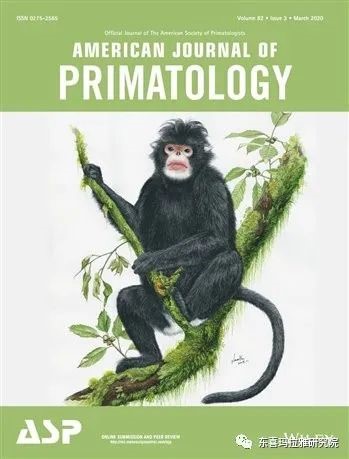 The photo of black snub-nosed monkey was used as the cover of AJP The photo of black snub-nosed monkey was used as the cover of AJP
Its research team published an important article on Black snub-nosed monkey research in American Journal of primatology, so that the photo used is shown on the cover of the journal.
A recent cooperation between the Institute of Eastern-Himalaya Biodiversity Research at Dali University, and Australian National University has resulted in a significant achievement from the project focusing on Gaoligongshan National Nature Reserve. The Cafeteria-style feeding trials applied to the project have provided new insights into the dietary and nutritional strategies of the black snub-nosed monkey (Rhinopithecus strykeri). The results provide significant information and evidence in amending the conservation strategies for its conservation, a critically endangered primate species. The photo published in this article is shown on the cover of the journal, the most prestigious academic journal in primatology.
The black snub-nosed monkey (also known as Nujiang snub-nosed monkey in China) is a newly defined primate species that was first discovered in Myanmar in 2010. So far, this species is only seen in a narrow area in the Gaoligong Mountains, the border between China and Myanmar. There may be 10 groups in China and another 4 Myanmar. The total number may be less than 950, so that the species is listed as extremely endangered animal on the list of IUCN Red List (CR). Due to its environments and habits embedded with extremely diversified mountainous topography, plus a long duration of the rainy season in the region, the studies on its ecology, dietary choice, reproduction, behavior and conservation become very difficult.
Researchers from the Institute and Australian National University conducted this research in National and Nature Reserve from 2016 to 2019. They carried on a buffet experiment on the two rescued monkeys, analyzing the components of the collected buds, tender leaves, and old leaves from 118 and other unidentified 54 plant species consumed by the monkeys. Nutrient analysis showed that this monkey species tends to choose leaves and leaf buds with high moisture (77.7%), high protein (21.2%), high total unstructured carbohydrates (34.9%), and high phosphorus (0.37%) content. It avoids the leaves and leaf buds with too much cellulose (neutral detergent fiber is greater than 46.8%). This implies that cellulose is not easily digested, which can hinder the processes of digestion and absorption of the nutrients. The leaves selected by the species in autumn are slightly more in metabolic energy (ME) than those selected in spring (1,350 kJ / 100 g VS. 1,268 kJ / 100 g). On the contrary, protein content taken by the monkeys in spring is higher (22.9%) than in autumn (16.4%). The results from the “random forest” model shows that the proportion of water, neutral detergent fiber, metabolic energy, crude protein, phosphorus and carbohydrates are the key factors to determine which plant parts the monkeys are feeding. Based on nutritional characteristics of the food consumed during the two seasons, the research team identified 18 nutrient-rich native plant species. Thus, they suggested that these plants should be used for ex-situ conservation and habitat restoration plans for the species.
Dr. Yang Yin at the Institute is the first author. Professor Xiao Wen at the Institute and Associate Professor Alison Biehe at the Australian National University are the co-corresponding authors. Wang Xinwen at the Gaoligongshan National Nature Reserve participated in part of the experimental work.
(source:admin) |